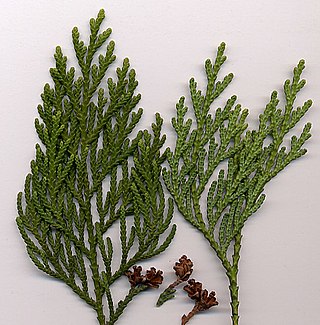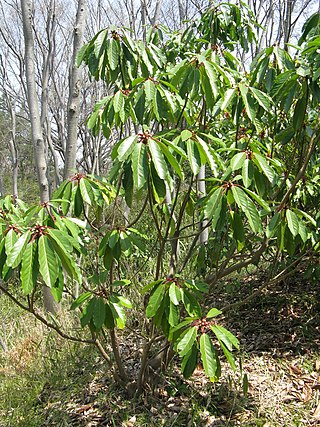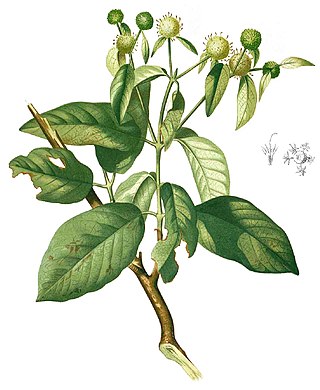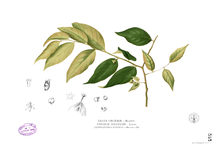
Thuja is a genus of coniferous tree or shrub in the Cupressaceae. There are five species in the genus, two native to North America and three native to eastern Asia. The genus is monophyletic and sister to Thujopsis. Members are commonly known as arborvitaes, thujas or cedars.

Platycladus is a monotypic genus of evergreen coniferous trees in the cypress family Cupressaceae, containing only one species, Platycladus orientalis, also known as Chinese thuja, Oriental arborvitae, Chinese arborvitae, biota or Oriental thuja. It is native to northeastern parts of East Asia and North Asia, but is also now naturalised as an introduced species in other regions of the Asian continent.

Codiaeum variegatum is a species of plant in the genus Codiaeum, which is a member of the family Euphorbiaceae. It was described by Carl Linnaeus in 1753. It is native to Indonesia, Malaysia, Australia, and the western Pacific Ocean islands, growing in open forests and scrub.

Campylospermum serratum is a plant in the family Ochnaceae. The specific epithet serratum is from the Latin meaning "with teeth", referring to the leaf margin. It is found in Tropical Asia, from Sulawesi, Indonesia to Hainan, Zhōngguó/China and over to southwester India. Gomphia serrata was a previous common name for the species. The plant is used for it wood and its sap is used in folk medicine and in the past for teeth-blackening.

Weinmannia trichosperma, the tineo, is an evergreen tree in the family of Cunoniaceae, it is native to Chile and Argentina: 35 to 47°S. endemic to laurel forest habitat.

Cinnamomum iners is a tree species in the family Lauraceae described by Reinwardt and Blume. No subspecies are listed in the Catalogue of Life. It occurs naturally in Myanmar, Thailand, Laos, Cambodia, Vietnam, Malaysia, Indonesia, Brunei, Singapore, the Philippines and southern China.

Myristica fragrans is an evergreen tree indigenous to the Maluku Islands of Indonesia. It is important as the main source of the spices nutmeg and mace. It is widely grown across the tropics including Guangdong and Yunnan in China, Taiwan, Indonesia, Malaysia, Grenada in the Caribbean, Kerala in India, Sri Lanka and South America.

Quercus myrsinifolia is an Asian species of tree in the beech family Fagaceae. It has several common names, including bamboo-leaf oak, Chinese evergreen oak, and Chinese ring-cupped oak. Its Chinese name is 小叶青冈; pinyin: xiǎo yè qīng gāng, which means little leaf ring-cupped oak, in Japan it is called white oak and in Korea it is known as gasinamu (가시나무). It is native to east central and southeast China, Japan, Korea, Laos, northern Thailand, and Vietnam. It is placed in subgenus Cerris, section Cyclobalanopsis.
Quercus asymmetrica is an oak tree species in the beech family Fagaceae. It is found in China and northern Vietnam. It is placed in subgenus Cerris, section Cyclobalanopsis.

Daphniphyllum macropodum is a shrub or small tree found in China, Japan and Korea. Like all species in the genus Daphniphyllum, D. macropodum is dioecious, that is male and female flowers are borne on different plants. The timber is used in China in construction and furniture making. It is grown as an ornamental plant, chiefly for its foliage.

Sterculia urens is a species of plant in the family Malvaceae. It is native to India and has been introduced into Burma. A small to medium-sized tree with a pale-coloured trunk, it is commonly known as the bhutyā in Marathi, kulu, Indian tragacanth, gum karaya, katira, sterculia gum or kateera gum. The specific name urens refers to the stinging hairs present on the flowers.

Terminalia phillyreifolia is an Asian species of tree in the family Combretaceae. It has been called buttontree or yon. It is a medium-sized tree found in both primary and secondary tropical and sub-tropical forests. It is recorded from India to China, south to Thailand and Vietnam. It may be one of the dominant species of deciduous forests of Vietnam. In Yunnan it is found in rocky limestone areas, near sea level to 700 m (2,300 ft).

Spondias pinnata, sometimes also known as hog plum, is a species of tree with edible sour fruits. It is native to the Philippines and Indonesia, but has been widely naturalized in South Asia, Mainland Southeast Asia, Southern China, and the Solomon Islands. It belongs to the family Anacardiaceae. This species, among several others, has sometimes called the "wild mango" in other languages and was once placed in the genus Mangifera. It is found in lowlands and hill forests up to 1,200 m (3,900 ft).
Cleistanthus schlechteri is a plant species first described by Pax, with its current name after Hutchinson; it is included in the family Phyllanthaceae.

Mitragyna diversifolia is a tree species in the family Rubiaceae and found in Asia. The Catalogue of Life lists no subspecies.
Garcinia celebica is an accepted name of a tree species in the family Clusiaceae. The Catalogue of Life lists no subspecies.
Reinwardtiodendron humile is a small tree species in the family Meliaceae. There are no subspecies listed in the Catalogue of Life.
Ficus sumatrana is an Asian species of fig tree in the family Moraceae. No subspecies are listed in the Catalogue of Life; its native range is Indo-China to Malesia.
Utania racemosa is a species of flowering plant in the family Gentianaceae. It occurs in Southeast Asia from Sumatera in Indonesia to the Andaman Islands in India. Its wood is used for timber and fuel.

Cleistanthus hylandii, commonly known as Bernie's Cleistanthus, is an evergreen plant in the family Phyllanthaceae which is endemic to Cape York Peninsula in far northern Queensland, Australia.














